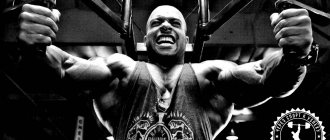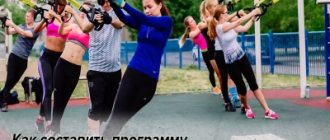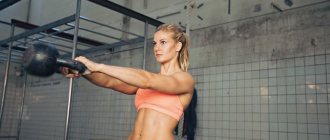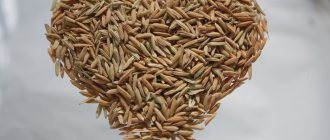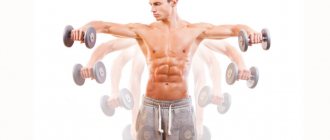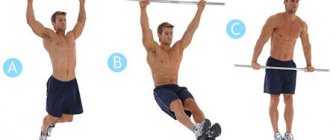28 June 2021 Admin Home page » Tips and tricks
Find out how to build broad shoulders as quickly as possible, with minimal risk of injury. Only proven advice from professionals!
Many gym goers use the rule, lift more and you will get bigger, these words have some truth, but they need to be used wisely. Dumb lifting of weights will give initial results, but then you will not get the long-awaited effect and your results will stall, plus you will get injured.
To do this, you need to connect your brains, use different training schemes, apply different degrees of load, and so on. We present to your attention 16 main rules for the correct development of shoulders, with minimal possibility of injury, remember them so that training your shoulders for weight will be successful.
It starts with the overhead press
Start working on your deltoids with a seated press while you are full of strength and energy; you can do it with both a barbell and dumbbells; it is better to alternate them, rather than focus on one of them. This basic exercise perfectly works all 3 areas of the deltoids, triceps and other supporting muscles; it is very important to work in the range of 6-12 repetitions, this is where muscle hypertrophy comes into play.
Do not try to do this exercise at the end of a workout, when the muscle fibers are working with the rest of their strength, you lift a small working weight, and you will not work the muscles well.
Features of shoulder training
A few tips on how to train:
- Work each delt with 1-3 exercises. Keep in mind that basic exercises do not fully utilize all the bundles, so be sure to add isolated exercises.
- Training should not be done every day, as the muscles will not have time to recover.
- Always do a warm-up. Even if it's a leg + shoulder workout, try to warm up your whole body a little.
- Do not lift sports equipment in jerks; do it slowly. This way you will increase the effectiveness of the exercise and avoid unnecessary vibrations and injuries.
- For split classes, a joint workout of legs + shoulders is suitable. With this approach, the bottom is pumped first, and then the top.
- Increase the weight of dumbbells and barbells gradually.
Do seated and standing presses
There is no fundamental difference between these 2 exercise options, but there is one significant difference.
When performed in a seated position, you work the shoulders more specifically, which is better for more targeted delt pumping, but it doesn't allow for the use of lower body strength. Therefore, you can handle the weight, much less, and reduce the number of repetitions.
If you use the standing option, this is called a military press, here you can work with heavier weights and increase the number of repetitions, due to the fact that the initial impulse of the movement comes from the lower part of the body, including the legs, abs, and lower back in the work. It is recommended to use an athletic belt in heavy approaches so as not to damage the lower back. Precisely because more weight is taken, more muscles are involved in the work and the mass of not only the shoulders, but also the whole body increases.
Alternate these exercises, this will give impetus to the development of large deltoids.
How to pump up your rear delts
Goal: building up the posterior deltoid muscles
The posterior deltoid muscles often lag not only in beginners, but also in advanced bodybuilders. Simply put, they don't get as much stimulation as the front and middle deltoids, which are involved in chest exercises and shoulder presses.
To develop your rear delts, perform this routine for 4-8 weeks, or alternate it with a more balanced shoulder workout.
A set of exercises for the rear deltoids
- Overhead Press – 4 sets of 8-10 reps (2 minutes rest)
- Bent-over dumbbell raises - 4 sets of 8 reps (60-90 seconds rest)
- Crossover raises - 3 sets of 10 reps (60-90 seconds rest)
- Butterfly raises - 3 sets of 10-12 reps (60-90 seconds rest)
Make sure your shoulders develop evenly
Uneven development of the shoulders is not only noticeable and unsightly, but can also be the cause of a rotator cuff injury.
Guys who often train their chest and do other exercises to develop it have larger front deltoids than their side ones. At the same time, they do not pay special attention to the sitting press, because the main thing is to have a beautiful, powerful chest.
Because of this, the shoulders look underdeveloped in appearance, the chest is large, and the shoulders are not wide enough. Not liking traction exercises for the back leaves the rear part of the deltas out of work.
All this leads to weakness of the shoulder joints, which may not withstand the load of strength exercises, as other muscles grow and require more and more load.
The first exercise for the deltas is the bench press, and the second should go to the lagging part of the shoulder, and then to the more developed area.
How often to exercise
If you have just started training and have been training for several months, then there is an optimal scheme for you. You need to pump all muscle groups in one workout three times a week.
To do this you need to use basic exercises. They help grow overall muscle mass.
We recommend reading: Raising legs while hanging on a bar: detailed technique and execution options
After training for several months, you can switch to split and separate training.
You need to divide the whole body into two parts, and train according to the 2+1 scheme, two days of training, then a day of rest. Or 2+1, 2+2.
Let's give an example of how many times a week you need to pump certain muscles:
Monday: you can pump up your chest, triceps, deltoids
Tuesday: trains back, biceps, legs
Thursday: you can pump up the chest, triceps, deltoids
Friday: back, biceps, legs trained
Thus, each muscle group is trained twice a week. During this period, the loads are not yet large enough, so the muscles need several days to recover.
Further, at a more advanced level, after about six months of strength training, an even larger split is drawn up, in which only two muscle groups are pumped in one workout.
We recommend reading: Exercises for back muscles at home for men
Since the muscles will receive increasing stress, they will need more time to recover and continue to grow. Here you need to start adhering to this principle: large muscle groups need to be trained no more than once a week. Small muscle groups require less recovery time, so with a weekly split there are two options for training them, once or twice a week.
What muscles should you exercise how many times a week?
For example, when large and small muscle groups are pumped once a week:
Monday: you need to pump up your chest, triceps
Wednesday: back, biceps training
Friday: deltoids and legs swing
And with this split, large muscle groups are trained once a week, and small muscle groups are trained twice a week. One day, small muscle groups work while pumping up large ones, and the second time, targeted training of these small groups takes place.
Monday: chest, biceps pump (triceps and front delts work during presses)
Calculate your ideal sports weight!
Wednesday: trains back, triceps (biceps and rear deltoids work during back training)
Friday: shoulders and legs swing
Another option is a split, when your arms are trained on one day:
Monday: you need to pump up your chest, deltoids
Wednesday: back, legs trained
Friday: you can pump your arms
Saturday and Sunday: rest
With this split, large muscle groups are pumped once a week, small muscle groups - twice a week.
These are just the simplest examples of strength training, there are many options. When answering the question: how many times a week should you train different muscle groups, you must not forget about the recovery factor. The time that muscles need to recover is determined only empirically, since it is individual for each bodybuilder and depends on various parameters.
How often can you train one muscle group?
For example, if you pumped your triceps in the last strength training, and it didn’t have time to recover, and in the next workout you started pumping your chest, then your results in the bench press will noticeably decrease. Therefore, you need to select a strength training regimen experimentally.
If you are an ectomorph, a split is perfect for you, in which only one muscle group is pumped in one strength training session. Ectomorphs require much more recovery time than athletes with other body types, so one muscle group should be trained no more than once a week.
With age, recovery time increases, so middle-aged athletes should train each muscle group no more than once a week.
Most novice bodybuilders are interested in the question of how many times a week they need to pump one muscle group. In response to this question, bodybuilding experts have the opinion that it is not advisable for beginners to train isolated muscle groups, since in novice athletes the most intense increase in muscle mass is observed when performing basic exercises.
In addition, you need to take into account that beginners in the gym do not want long duration of strength training. An hour or an hour and a half is enough. But girls can pump up their buttocks every day. We talked about this in detail here.
How many times a week should you train muscles to lose weight?
How many times a week should a girl or man exercise to lose weight? To quickly lose excess body weight, you can exercise daily. The minimum amount of strength training for weight loss is three times a week.
For those people who come to the gym just to pump up the muscles of their legs, arms, abs, back, buttocks, strength training should be less intense. A regime of 3 workouts per week is suitable for them. The strength load will depend on how many times a week and what muscles need to be pumped.
How many times a week should girls train to lose weight?
Speaking about training for weight loss, you need to remember about aerobic training for girls. Daily aerobic training while reducing calorie intake can have the opposite effect than desired. Instead of speeding up your metabolism and losing weight, your body may increase the amount of fat it produces instead of burning it.
Losing weight should always start with proper nutrition. Exclusions of fast carbohydrates and excessively high-calorie foods. Physical training for fat burning will only be a way to normalize metabolism and equalize blood sugar levels, and not at all a mechanism for getting rid of excess calories and “burning” fat.
How many times a week to pump your legs
The leg muscles are one of the largest muscle groups in the human body. Therefore, it is advisable to train the leg muscles no more often than once every 72 hours. In other words, if you did heavy barbell squats on Monday, your next leg workout would be Thursday or Friday. However, if you only trained your calves or inner thighs, the time will be reduced.
At the same time, the final number of days required to restore the leg muscles also depends on the person’s body type. Athletic mesomorphs can train more often. They usually build muscle quickly. Whereas the body of thin ectomorphs or overweight endomorphs requires an increased amount of time to replenish energy reserves.
How many times a week should you pump your abs?
Beginning athletes can pump up their abs 5 times a week in the first months of strength training. The presence of “delayed” pain will help you literally feel your abdominal muscles. This will dramatically increase the effectiveness of your abdominal workout. However, we are talking about performing single exercises without additional loads or simple training at home.
Complete sets of exercises for developing abdominal muscles will require about 48-60 hours for recovery. Separately, we note that more frequent training of the abdominal muscles is completely incapable of removing fat from the abdomen. This requires exceptionally proper and balanced nutrition.
The optimal workout plan for pumping muscles throughout the body
One day the legs and buttocks sway; back and arms. The second day you can pump your legs and buttocks; press. On the third day, you can pump your legs and buttocks again; back and arms.
This is done because the leg muscles recover faster and require more time to train them. Abdominal muscles usually take a very long time to recover. Therefore, you can pump your abs once a week. It is better to train the arm and back muscles no more than 2 times a week.
It is best to train in the gym of a fitness center or health center with a personal trainer. He will help you create a training plan. He will tell you which muscles to train how many times a week and will monitor the execution of the exercises. You can learn about this in our publication “What is personal training in sports.”
You can find out how to exercise at home in quarantine during self-isolation “here”.
Take care of your rotator cuff
It is responsible for the circular movements of the arms in the shoulders, so neglecting it can lead to negative consequences. Few train it, it doesn’t matter how much you pump it, it’s not visible, but its main task is not to show off externally, but to balance the shoulder joint.
Rotator cuff - consists of 4 muscles, always before training your shoulders, take small dumbbells in your hands and perform circular movements with your arms, slightly bending your elbows. Perform 10-15 rotations forward and then backward, repeat this for 2-3 approaches.
Shoulder training: program for beginners and professionals
When we talk about shoulder training, we mean developing the deltoid muscle. It consists of three bundles:
- front,
- average,
- rear
The structure of the deltoid muscle is such that no shoulder exercise can evenly and simultaneously load all three deltoid muscles. This leads to the fact that shoulder training in the gym should consist of 2-3 basic exercises and several isolated ones.
Before starting the main program, warm up. To warm up your muscles, you can perform the first set with a lighter weight.
React instantly to pain
Sharp pain during exercise is bad pain and is nothing like muscle pain after exercise. If it occurs, immediately finish the exercise and move on to another, similar one.
For example, replacing a barbell bench press with a dumbbell press puts your shoulders in a more natural position, does not break them out as much and is less traumatic, although it does not allow you to take on such a large working weight.
At the first manifestation of pain, do not kill the muscles by clenching your teeth, immediately apply measures - massage, ointments, ice application, otherwise you will be treated by doctors and severe inflammation of the shoulder cuff will leave you behind training for a long time.
Train your shoulders in a variety of ways
Shoulder mass training requires variety; don’t get stuck on the same exercises and don’t perform exercises with the same weight. As muscles adapt to the load, they respond less over time and muscle growth slows down.
Therefore, do different exercises, alternate load phases from heavy for 6 repetitions, to medium for 8-10 repetitions and light for 12-14 repetitions. Change the angles of inclination, body positions, use dumbbells, barbells, exercise machines and crossovers, you can see the full list of exercises here.
What shoulder exercises to do
How to pump up the front delts
Standing dumbbell press
Raise your hands with the selected weight to shoulder level, turn your palms with your fingers forward. Press the dumbbells up and slightly behind your head, then lower them to the starting position and repeat.
Do three to five sets of 10–12 reps.
Standing chest press
Take the projectile on your chest, bring your elbows forward, tense your abs, buttocks, and legs. Press the barbell up, lower it back down, and repeat.
When the bar passes your face, do not lift your chin up, but press it in: this way the bar will pass along the optimal path.
If at the top point the projectile remains in front of the body and not above it, the load on the lower back increases. Therefore, try to move the bar behind your head.
Do three to five sets of six to eight reps.
Handstand push-up
This exercise has not been tested using EMG, but the movement itself replicates the barbell press up in a reduced range.
Get into a handstand with your feet against the wall. Bend your elbows, lower yourself and touch the floor with your head. Push yourself back up and repeat. Be careful when placing your head on the floor: careless movements can injure your neck.
To make the exercise easier, place something under your head, such as a folded blanket or several thick books. To make it more difficult, place a solid support under your hands.
Perform as many times in a set as you can. Do 3–5 approaches, depending on how you feel.
How to pump up middle deltoids
Incline dumbbell row
Set the bench at a 45-degree incline and lie on your stomach. Hold the dumbbells with your arms extended and lowered, with your wrists facing forward.
Squeeze your shoulder blades together, point your shoulders back and bend your elbows at right angles. At the extreme point, the shoulders are in the same plane with the body, and the forearms are perpendicular to it and directed towards the floor. Slowly return to the starting position and repeat.
Do three to five sets of 10–12 reps.
Barbell row to the chin
Grab the barbell with a grip 1.5–2 times shoulder width. This starting position ensures Effect of grip width on electromyographic activity during the upright row maximum involvement of the middle delts in this exercise.
Raise the barbell to the level of your collarbones, pull your elbows up. Lower the bar and repeat.
Perform three to five sets of eight repetitions.
Dumbbell lateral raises with a turn
Stand up straight, take dumbbells, point your wrists with your fingers towards each other. Spread your arms to the sides, turning your little fingers up. Lower to the starting position and repeat.
Do three to five sets of 10–12 reps.
Exit to side plank on forearm
Stand in a lying position, place one hand on your forearm. Place the palm of your other hand on the opposite shoulder. From this position, rotate your body to the side into a forearm plank and then return to the starting position.
Perform the exercise as many times in a set as you can. Then switch hands and repeat. Do three sets with each arm.
How to pump up your rear deltoids
Seated dumbbell flyes
Sit on a bench, bend your body with a straight back, as far as flexibility allows, hold dumbbells in your lowered hands. Without changing the position of the body, spread your arms with the weight taken to the sides to shoulder level. Slowly lower the dumbbells to the starting position and repeat.
Do three to five sets of 10–12 reps.
Reverse butterfly
This exercise can be performed on a machine, with an expander or dumbbells. The main rule is to spread your arms outward, so that at the extreme point your little fingers are pointing upward.
If you want to perform an exercise with dumbbells, place a bench on two boxes, lie on it with your stomach and spread your arms with the weight to the sides.
Perform three to five sets of 10–12 reps.
Lifting from the floor using fists
Lie on the floor, spread your arms in a cross. Leaning on your fists, lift your upper body and try to lift your shoulder blades off the floor. It is important to use your abdominal muscles to a minimum: try to rise only with your arms.
Hold the position at the top, then lower to the floor and repeat. Perform as many times in a set as you can. Do three to five sets.
